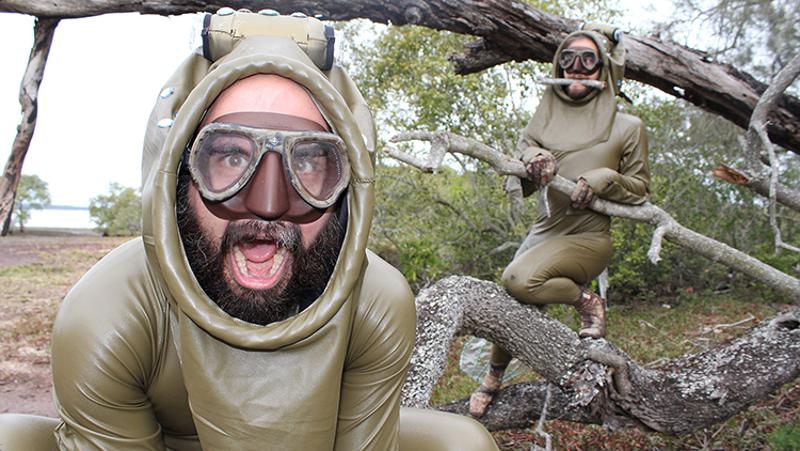
Once a realm solely for computer-generated imagery, 360-degree virtual reality (VR) technology is about to get uncomfortably real, taking audience participation beyond anything ever experienced.
CineStasia
Mudskipping
Visiting QUT academic Dr David Gillette, from California Polytechnic State University (Cal Poly), said the availability of small, affordable consumer VR headsets had triggered a shift to immersive, live-action 360-degree cinema.
Dr Gillette is at the forefront of 21st Century digital entertainment, a world leader in VR storytelling who is spearheading technology to give consumers a richer and more personalised cinematic experience.
“Live action VR completely removes that invisible wall between audience and performers – putting the audience literally in the middle of action – you’re not watching that conversation or car crash anymore, you’re participating in it,” said Dr Gillette, Director of Cal Poly’s Liberal Arts & Engineering Studies program.
“It’s a huge shift in thinking for screen writers and directors when the audience is placed at the centre of the action, essentially directing the camera with their head movements. How do you help the viewer separate what’s important and what’s noise in that 360 environment? How do you lead them in the narrative? These are just some of the new challenges we are addressing.”
Dr Gillette and researcher Ciera Dixon will share the latest developments in 360-degree VR technology with the public at QUT’s free CreateX festival on Sunday August 28.
Among the immersive VR videos the public can experience is the world-first video that combines 360-degree visuals with truly immersive 360-degree sound – CineStasia.
Dr Gillette and his team developed CineStasia for world-leading sound technology company DTS as a proof-of-concept video, with research support from QUT spin-off company DeepBlue.
“While there have been great advances in immersive 360-degree VR visuals, sound technology until now hasn’t matched that experience,” Ms Dixon said.
“The sound technology underpinning CineStasia is dynamic - it matches the source of the sound no matter where you move your head around. We’ve demonstrated that effect using floating speakers that move around the viewer.”
The Cal Poly team is also developing storytelling best practices for VR headset Oculus Rift.
In this age of immersive entertainment, the researchers have found a surprisingly low-tech way to model 360-degree virtual environments and compelling storytelling – escape rooms.
“It’s hideously expensive, complex and time-consuming to model of 360-degree VR environments and stories inside a computer,” Dr Gillette said.
“Escape rooms are a simple way for us to test VR story development by experimenting with a range of interesting storytelling techniques to see what works best in VR.
“This marriage of cinematic storytelling and escape rooms is something we’ll see more often. Film studios are already starting to build them as public engagement tools.”
Affordable technology is also putting stereoscopic 3D film into the hands of independent videographers.
Award-winning filmmaker and QUT Creative Industries expert Dr Phoebe Hart’s 3D short film Mudskipping will also feature at CreateX.
Produced with a crew of talented filmmakers, composers, designers and dancers – most with QUT connections – Mudskipping combines film, dance, sound and humour to highlight the importance of our dwindling mangroves.
“Around 17 per cent of Australia’s mangroves have been destroyed since European settlement,” Dr Hart said.
“We often think about plants and animals as having little to do with our human lives. Mudskipping is a reminder than we humans are a part of nature, not separate from it.”
As affordable technology drives further innovation, Dr Gillett believes 360-degree VR experiences will become even more immersive.
“We’re going to see a lot more diverse, person-to-person interactions within these environments, with the technology invisibly facilitating those interactions,” he said.
“I also think VR headsets will be a short-lived fad as the Internet of Things takes over. Embedded technology within household furnishings will connect remotely with the VR platform and provide the visual and sound components required for the immersive experience.”
Media contacts:
Kate Haggman, QUT Media, 07 3138 0358, kate.haggman@qut.edu.au
After hours Rose Trapnell, QUT Media team leader, 0407 585 901, media@qut.edu.au
QUT is part of a national collaborative group of five major Australian universities that form the ATN (Australian Technology Network of Universities).


